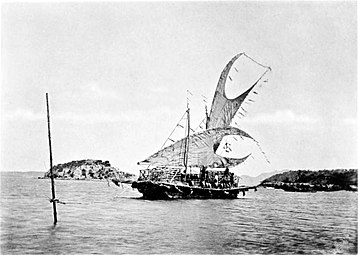
Lakatoi (also Lagatoi) are multiple-hulled[1] sailing watercraft of Papua New Guinea.[2] They are named in the Motu language and traditionally used in the Hiri trade cycle.[3]
Lakatoi (whose literal meaning is three dugouts) are fashioned from two or more dugout logs fastened together to give stability and cargo-carrying capacity.[1] The two or more dugouts are joined by booms, with a platform built on top.[4] The sail is a crab-claw sail.[5] Horridge (2008)[6] discusses the rig and how the craft is manouvred.
Gallery
[edit]-
Loading a lakatoi at Port Moresby, prior to 1885.
-
Lakatoi near Elevala Island, prior to 1885.
-
Papuan lake dwellings with a lakatoi under sail, 1898 or before.
-
1901 stamp by the British Government depicting a lakatoi.
See also
[edit]References
[edit]- ^ a b Mahdi, W. (1999). "The dispersal of Austronesian boat forms in the Indian Ocean" (PDF). Archaeology & language III, Artefacts, languages and texts: 144–208.
- ^ "Journal of the Polynesian Society: Front Matter P 1-6". Jps.auckland.ac.nz. Retrieved 2016-01-19.
- ^ "Motuan traders go west in their Lakatoi". II(8) Pacific Islands Monthly. 11 March 1932. Retrieved 26 September 2021.
- ^ Pawley, A., & Pawley, M. (1998). "Canoes and seafaring" (PDF). The Lexicon of Proto Oceanic: The Culture and environment of ancestral Oceanic society 1: Material Culture. Pacific Linguistics.
((cite journal)): CS1 maint: multiple names: authors list (link) - ^ "Motuan Traders Abandon Ancient Lakatoi Custom". Pacific Islands Monthly. 1935-02-21. Retrieved 2024-03-18.
- ^ Horridge, A (2008). "Origins and Relationships of Pacific Canoes and Rigs" (PDF). Canoes of Oceania. V: 85–105.
| Overviews | |||||||||||||||||
|---|---|---|---|---|---|---|---|---|---|---|---|---|---|---|---|---|---|
| Sailing rigs | |||||||||||||||||
| By sailing rigs | |||||||||||||||||
| Multihull vessels | |||||||||||||||||
| Naval and merchant sailing ships and other vessels (by origin date) |
| ||||||||||||||||
| Fishing vessels | |||||||||||||||||
| Recreational vessels | |||||||||||||||||
| Special terms | |||||||||||||||||
| Other types | |||||||||||||||||
| Related | |||||||||||||||||








